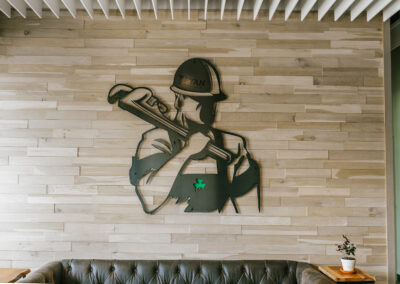Nearly every business stores product or stock – from paper files to raw materials to finished goods. Regardless of what is being stored, traditional storage spaces such as warehouses or even the most unassuming storage room can present a unique fire control challenge. Building owners, managers or facilities supervisors should pay particular attention to 3 critical factors when evaluating their fire control options.
For most situations fire control would include a sprinkler system. A sprinkler system is designed to control or suppress a fire in its earliest stages with a limited number of sprinklers operating. However, it is critical that the sprinkler systems are properly designed and installed for the occupancy they protect – in this case, the type of commodity being stored and the manner in which it is stored.
Three Critical Factors
Your sprinkler system design should consider these three factors:
- Commodity Classification — classification based on the type of product stored, including container and packaging materials.
- Storage Arrangement — whether the product is stored in racks or piles or on pallets, the type of shelving, clearance to the roof, aisle width, etc.
- Storage Height — maximum height of storage in relation to the height of your building.
Commodity Classification
There are five basic commodity classes. These classes range from metals to plastics, with plastics being the most difficult to protect. The basic commodity classes are:
- Class I: noncombustible products in single-layer corrugated cartons such as noncombustible liquids in glass containers, canned food, ice cream and metal parts
- Class II: Class I products in slatted wood crates, wood boxes, multiple layered corrugated cartons, waxed-paper containers or equivalent packaging
- Class III: wood, paper, natural-fiber cloth or Group C plastics and a limited amount of Group A or B plastics (5 percent or less by weight or volume)
- Class IV: Class I, II or III products containing a significant amount of Group A plastics (5 to 15 percent by weight or 5 to 25 percent by volume) in ordinary corrugated cartons; Class I, II and III products in corrugated cartons with Group A plastic packing, with or without pallets
- Plastics: subcategorized into three main groups:
- Group A — the fastest burning and the most common; includes many of the plastics commonly used in toys and household products.
- Group B — burns moderately and is less common; includes nylon and natural rubber.
- Group C — the slowest burning; products such as CPVC and melamine.
There are additional materials and products that do not fall into the above commodity classifications that also pose severe fire hazards. Due to the complicated nature of these products, it is best to discuss with a fire control expert.
Storage Arrays
Product can be stored in a number of ways, called arrays. Each array has specific protection requirements that are affected by physical characteristics such as aisle and flue space and the location of shelving and obstructions to water penetration. There are seven common storage arrays:
- Solid pile — stacked commodity stored directly on the floor.
- Palletized — stacked commodity stored on pallets, on the floor, or on other pallet loads.
- Single racks — no more than 6 feet deep with a minimum aisle width of 3.5 feet.
- Double row racks — no more than 12 feet deep with a minimum aisle width of 3.5 feet.
- Multiple row racks — greater than 12 feet deep or are single and double row racks with aisle spaces less than 3.5 feet wide.
- Shelf storage — up to 2.5 feet deep with shelves usually 2 feet apart vertically; separated by approximately 2.5-foot-wide aisles.
- Bin box — five-sided wood, metal, cardboard or plastic boxes with the open face on the aisle. Bin box storage arrays create unique fire control challenges, collecting the water from sprinklers and preventing even distribution down through the racks.
Storage Height
Storage height, though a consideration of storage array, presents a unique host of circumstances when evaluation fire control. As storage height increases, a sprinkler system must be designed to accommodate the heights. Because fire spreads faster vertically than horizontally, a greater force of water from the sprinklers is necessary to reach the base of the fire. If the storage height exceeds the system’s design criteria, in-rack sprinklers may be necessary to control the fire. Another option is an early suppression, fast response (ESFR) system. It will typically allow an increase in storage height for some commodities without requiring in-rack sprinklers.
Other Considerations: Clearances and Obstructions
In addition to being designed for the proper storage height, sprinklers must have proper clearance and be free from obstructions. Too little or even too much clearance can affect the water’s ability to penetrate to the base of the fire, reducing its ability to slow fire growth. Furthermore, sprinkler system designs assume no obstructions, and that means clear aisles. Storage in the aisles could allow a fire to spread across an aisle to adjacent racks. Therefore, aisles must be kept free of storage to maintain the integrity of the sprinkler system design.
To determine if any changes in your facility could impact your sprinkler system, consider the effects of commodity class, storage height and storage array on your sprinkler system’s ability to control a fire. What you may consider a minor change could have a significant impact on the effectiveness of your sprinkler system.

